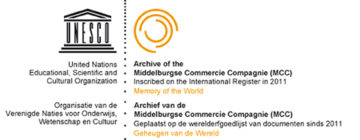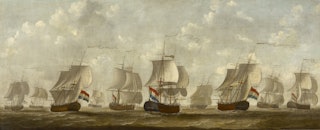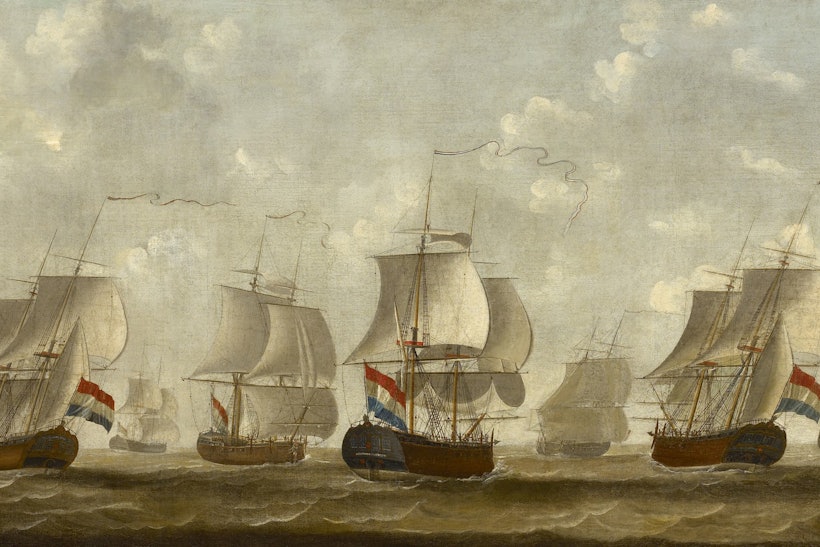
The Middelburgse Commercie Compagnie (MCC) traded approximately 31.000 African individuals who were forced into slavery. What is nowadays considered to be a crime committed without any conscious, was at the time nothing more than business as usual. The MCC was founded in 1720 and continued to exist until 1889.
While the MCC’s activities originally focused on the trade between ports at the Baltic sea, France, Iberian peninsula’s, the Mediterranean, the West-Indies and Africa, they also briefly ventured in the whaling business.
Triangular trade
After 1730, the MCC ships got involved in the triangular trade between Africa – The West Indies and Europe. The frigate ‘Hof van Zeeland’ left on the first slave trade journey in 1732.
The frigate sailed to the coast of Angola, while filled with various types of merchandise, amongst which lots of textiles, guns and gunpowder. Here, they traded their merchandise for living cargo consisting of men, women, boys and girls. The Africans who were forced into slavery were brought aboard the ship in groups.
Slave no. 318 was a woman
A ‘male slave’ was the first to enter the deck of the ‘Hof van Zeeland’ on December 9th 1732. He was literally denoted as ‘number one’, a name was never recorded. He was traded for textile, a gun and a blue pigment, which altogether amounted to 19,5 Pees (Peso). The last slave, a woman, was brought aboard the ship almost four months later. She was traded for a total amount of 22 (peso) worth of materials, amongst which sixteen dozen knives. This last woman was number 318.
Deadly shark
On their first journey, the ship brought 186 men, 41 women, 65 boys and 26 girls aboard, however this does not mean that all of them were able to reach the destination alive. The firsts who did not survive, a man and a woman, died before the ship even departed. The woman, in an attempt to flee, had jumped overboard with four other women. Although, the crew was able to recapture four of them, a shark had bitten off the lower leg of the fifth woman who died due to her wounds.

Crossing the Atlantic
On April 1st 1733, the crossing of the Atlantic Ocean could finally begin. During the journey to Curacao, a subsequent total of 48 Africans had died, of which 41 men, a woman, 6 boys and 2 girls. The ship’s surgeon was unable to save their lives and thus consequently also lost part of the ship’s new merchandise. Moreover, the loss was recorded in the ship surgeon’s journal.
Financial justifications
Events during the journey can be traced back extensively in the records of the MCC, where money was concerned, things was recorded in detail. This applied to every journey and every ship. It is rather exceptional that all administration documents are preserved intact and in a relatively complete state.
Brandy for the King of Cabinda
Records regarding: the building of ships; the purchase of merchandise in Zeeland; the slaves imported at the coast of Africa; the sales in the West-Indies and the purchase of return goods for the journey back to Zeeland, all still exist. Just like the muster rolls noting all the crewmembers, the captain’s ship’s reports, and even a couple of journals from ship’s surgeons and journals regarding the sales of discharged ships. The gifts brought by the frigate ‘Hof van Zeeland’ to appease local rulers, who were the suppliers of living cargo, also can also still be traced back the ship’s administration. For example, it is known that the King of Cabinda highly appreciated brandy.
114 Slave voyages
The MCC slowly started to become increasingly involved in the trading of slaves. Documents on 114 slave voyages are kept in the archives. The MCC’s involvement in the slave trade flourished between 1756 and 1780. The company from Zeeland shipped approximately 31.000 African individuals who were forced into slavery, of which 27.345 eventually survived the ship’s journey.
Slave trade obstructed by wars
The final journey as part of the slave trade industry started in 1802, but like many other journeys, this one remained uncompleted. The trading efforts were first heavily obstructed and later made impossible by the fourth Anglo-Dutch war and the Napoleonic wars. Many MCC ships were recaptured by the British, as a result the company focused on the construction of ships for third parties rather than undertaking their own journeys. This development eventually lead to the disbanding of the shipyard and consequently also the disbanding of the MCC in 1889.

Inventory of the MCC Archive
After World War Two, the Government archivist for the province of Zeeland, dr. Willem Unger (1889-1963), has made an inventory of the archive. The data has been used extensively by national and international researchers, since its completion in 1951. The archive is prized for the excellent state in which the records are preserved. The inventory of the MCC archive can be read online.
Different functions of the archive
The archive has a wide variety of functions, for example it can be used to study slave trade, the building of ships, ship journals, journals of ship’s surgeons and the remarkable way of ‘double’ accounting. All records of the journeys were updated and kept onboard and in the offices in Middelburg.

Goal of the Zeeland Archives
The Zeeland Archives strives to bring the archive of the Middelburgse Commercie Compagnie to attention of an audience as large as possible. In 2010 Zeeland Archives had successfully contributed the archive of the MCC to be placed on the UNESCO-World heritage list, on behalf of the Netherlands, Suriname, and Curacao. Furthermore, the Zeeland Archives in cooperation with the national archive, have raised attention for the special world heritage status of the archives of the MCC and the Dutch West India Company (WIC), during a international symposium which took place in Amsterdam and Middelburg respectively on November 3rd and 4th 2011.
National commemoration in Middelburg 2014
The commemoration of the abolition of the Dutch slave trade, took place on June 15th. In 2014, the commemoration signified how the Dutch slave trade was abolished exactly 200 years ago. Several institutions in Zeeland have collectively organized a number of activities as part of this commemoration.
